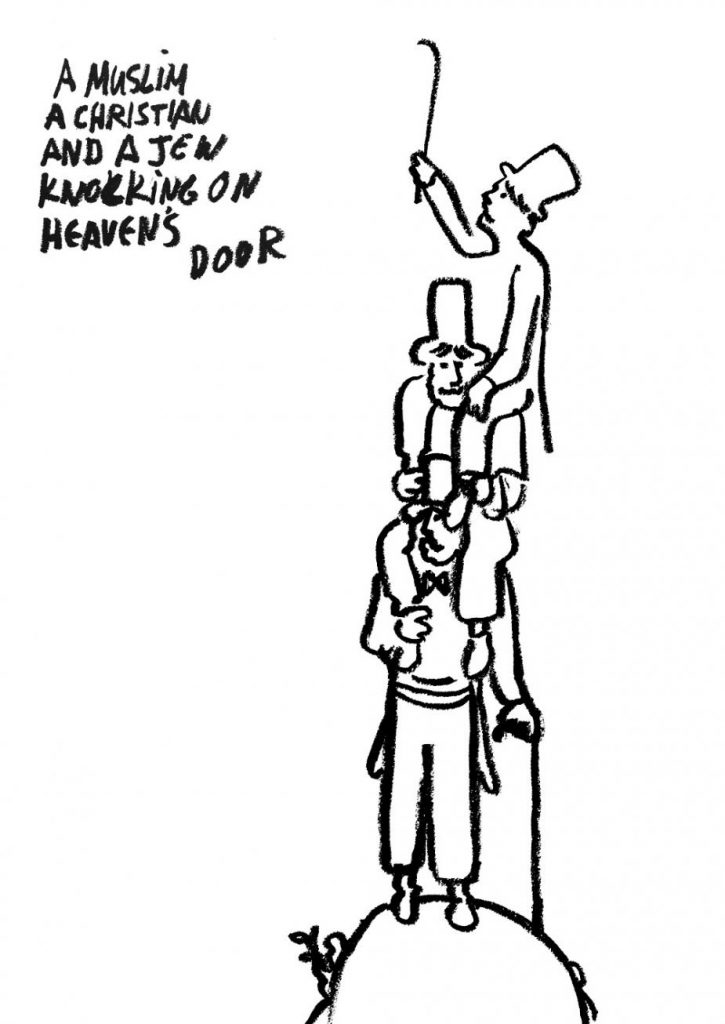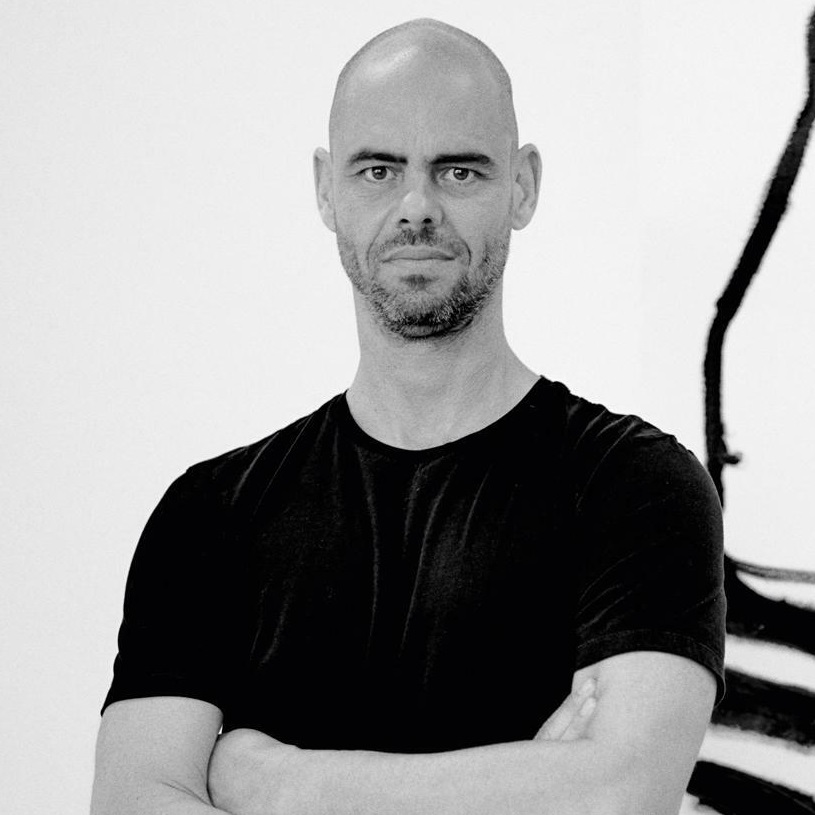“I don’t laugh about religion. I laugh about human behavior.”
On May 15th of 2019, our upcoming exhibition A Muslim, a Christian and a Jew is opening with Eran Shakine in attendance. Gregor Lersch, head of exhibitions at the Jewish Museum Berlin, spoke with the Israeli artist about religion, art, and his sources of inspiration.
What does A Muslim, a Christian and a Jew (MCJ) show?
“A Muslim, a Christian and a Jew… sounds like the beginning of a joke. But that is just to get your attention. The show is an installation consisting of paintings, drawings, and three metal cut-out sculptures. The three similar figures, their religious background unidentifiable, create situations by means of a vivid and comical body language. In every drawing they witness and experience major events in history or philosophy, or meet important figures like Moses, Buddha or Nelson Mandela. The three heroes, dressed as 19th century gentlemen, help each other in their journey to find the love of God. Here, there are no stereotypes, no one is the laughingstock, everyone is the same; we see three human beings who explore life, nature, culture and philosophy, out of shared curiosity, without trying to prove each other wrong.”
Why did you start to work on MCJ?
“Living in the Middle East is like living in the eye of a storm. Like trying to live a normal life on the edge of a volcano. In my lifetime, I have witnessed five wars (the first one at the age of six), and long periods of uncertainty in which life is threatened by suicide attacks. I also remember travelling with my family as a child, visiting towns and villages where people were genuinely happy to see us and were nice and friendly, places that today might be considered dangerous. In MCJ I wanted to remind us of simplicity and humility. It’s important to look at things happening around you with open eyes.”

What inspired you while working on MCJ?
“I remember reading Jules Verne’s Around the World in Eighty Days as a child while lying in the bomb shelter under our building. I was drawn into his abiding interest in man’s position in the cosmos—making him one of the last of the universal humanists. It was a much-used copy of the book and a bad translation, but I enjoyed it tremendously. Another major influence is The Adventures of Tintin by Hergé. I was always fascinated by his style of drawing; I also grew to love Japanese block printing and master painters like Katsushika Hokusai. I have become very interested in Japanese calligraphy. As a young adult, I was fascinated by archeology, I loved Ancient Greek vase painting and Greek mythology. In the late eighties I was living in New York City, and was struck by its street culture, especially graffiti works done by Jean-Michel Basquiat and Keith Haring. I think you can find all of these influences in MCJ.”

Why do all three individuals in the series have the same shape?
“Once you strip off everything we use in order to distinguish ourselves from one another, we all have the same basic need: We all want to be happy. How is the relationship of your art to classic art, e.g. to the art by Michelangelo you refer to in the Sketch A Muslim, a Christian and a Jew Visiting Moses, San Pietro in Vincoli? For me art is a mirror to society. The point with art of the past is that we can no longer know what this or that artwork was reflecting at the time. So we have to think what it means for us. If it doesn’t mean anything, it is not relevant anymore. Good art can be seen by different people at different times and stay relevant. That doesn’t mean it keeps the original intention of the artist. Most of the time it doesn’t.”
Is the Series MCJ characteristic of your artistic work?
“The appearance of my artworks change, but I am always dealing with the same subject: art as a mirror to culture and society. My last exhibition was called “Looking at You / Talking toMyself”, which dealt with the place one tries to put oneself in society. We know that today many of these self-representations—maybe a photo, shared instantly—are false. They express an idealized social image rather than showing the actual person.”
What is your relationship to religion?
“I don’t consider myself a religious person.”
What does distinguish Muslims, Christians and Jews? What do they have in common?
“They are related: two are the sons of Abraham, Ismail, and Isaac. And Jesus was born Jewish. They belong to the same family. Sometimes the worst enemies come from the same family. (Or the best of friends.)”
May we laugh about religion?
“I don’t laugh about religion. I laugh about human behavior.”
Can art make the world a better place?
“People can make the world a better place. Not art. Art can show a different way of looking at things, and hope to do the impossible: show a different path, a different journey. In the last few years, we have been reminded of the power of art in a negative way; cartoonists have been attacked and killed, and world treasures have been destroyed and lost forever. Artists and art can be manipulated and be manipulative. Art is a trigger; you just have to hope no one will get hurt.”
The interview was conducted by Gregor H. Lersch
head of exhibitions at the Jewish Museum Berlin

